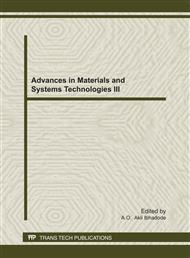[1]
ITU – Recommendation, 1. 371 (previously CCITT Recommendation), Traffic Control and Congestion Control in B-ISDN. (1993).
Google Scholar
[2]
Andreas P. and Ahmet S., Congestion Control: Book CI Congestion-Control- final. (Tech. doc. ). University of Cyrus, Nicosia Cyrus (1999).
Google Scholar
[3]
Chen, B. S., S. C. Peng, et al. Traffic modeling, prediction, and congestion control for high-speed networks: A fuzzy AR approach. IEEE Transactions on Fuzzy Systems, 8(5): (2000) 491-508.
DOI: 10.1109/91.873574
Google Scholar
[4]
Ishak, S. and H. Al-Deek, Evaluation of short-term time-series traffic prediction model. Journal of transportation engineering 128(6): (2002). 490-498.
DOI: 10.1061/(asce)0733-947x(2002)128:6(490)
Google Scholar
[5]
Zhou C. and Nelson P. C., Predicting Traffic Congestion using Recurrent Neural Networks, Proceedings of the 9th World Congress on Intelligent Transport Systems, Chicago, USA, (2002).
Google Scholar
[6]
Oki, E. and A. Iwaki. Performance comparisons of optimal routing by pipe, hose, and intermediate models. Sarnoff Symposium, 2009. SARNOFF '09, (2009), IEEE.
DOI: 10.1109/sarnof.2009.4850317
Google Scholar
[7]
Dudul S. V. and Ghatol, Identification of Linear Dynamical Time- Invariant Systems using Feedforward Neural Network. IE(I) Journal vol 84, (2004) pp.66-71.
Google Scholar
[8]
Monica Adya and Fred Callopy, How effective are Neural Networks at Forecasting Prediction? A Review and Evaluation, Journal of forecasting, University of Maryland Baltimore Counti USA, J. forecast 17, (1998) pp.481-495.
DOI: 10.1002/(sici)1099-131x(1998090)17:5/6<481::aid-for709>3.0.co;2-q
Google Scholar
[9]
Chichoki, A. and Unbehauen, R., Neural Networks for Optimization and Signal Processings. John Wiley and Sons Inc. USA, (1993).
Google Scholar
[10]
Goodman R. M. and Ambrose B. E. Neural Networks Applied to Traffic Management in Telephone Networks. Proceedings of the IEEE. Vol 84, no 10, (1992) 1421-1429.
DOI: 10.1109/5.537108
Google Scholar
[11]
Zhang, G. P. and M. Qi, Neural network forecasting for seasonal and trend time series, European Journal of operational research 160(2) (2005) 501-514.
DOI: 10.1016/j.ejor.2003.08.037
Google Scholar
[12]
Lin, X., X Wang, et al. Experiment on neural network prediction modeling of far infrared radiation drying for agaricus bisporus. Trans of the Chinese Soc of Agric Machinery 41(5): (2010) 110-114.
Google Scholar


